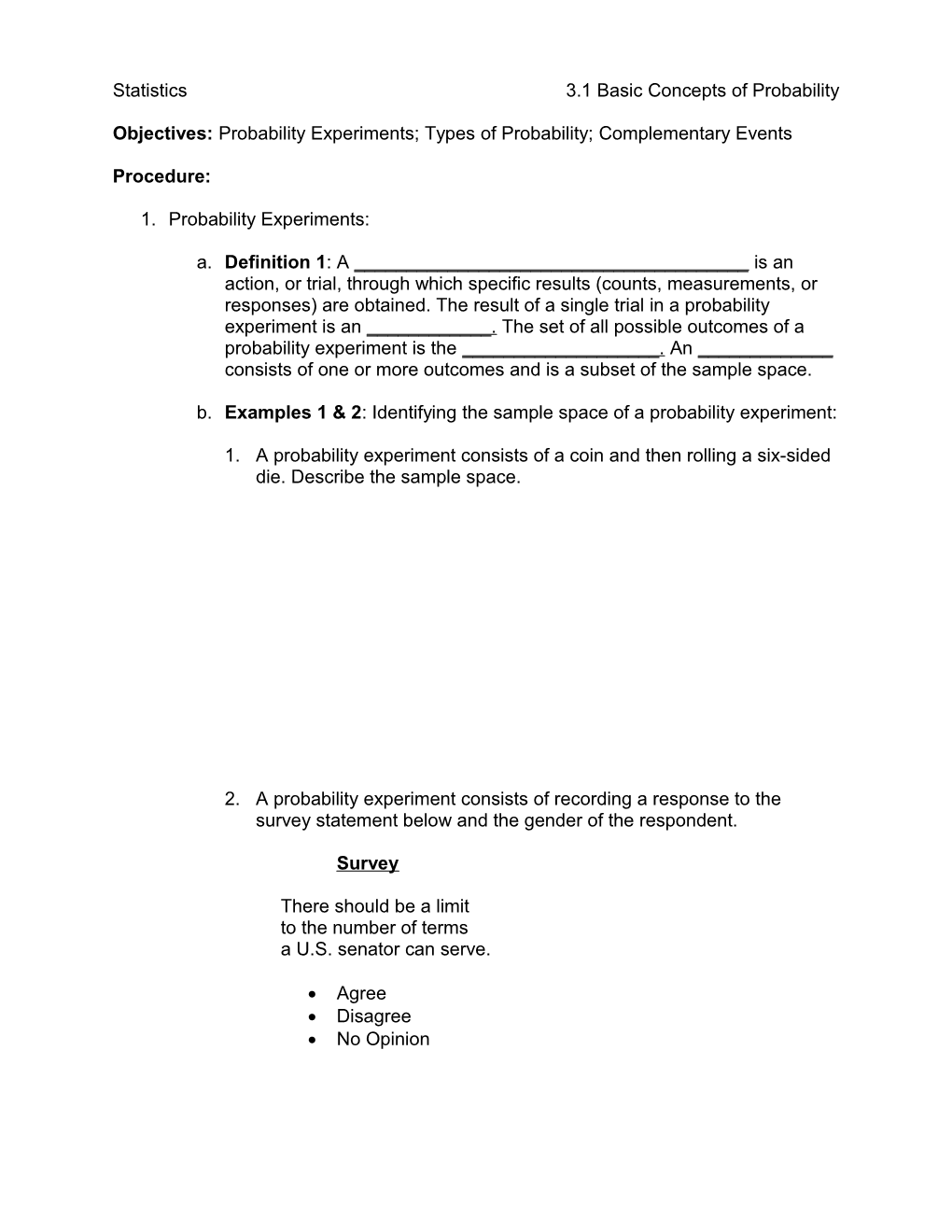Statistics 3.1 Basic Concepts of Probability
Objectives: Probability Experiments; Types of Probability; Complementary Events
Procedure:
- Probability Experiments:
- Definition 1: A ______is an action, or trial, through which specific results (counts, measurements, or responses) are obtained. The result of a single trial in a probability experiment is an ______. The set of all possible outcomes of a probability experiment is the ______. An ______consists of one or more outcomes and is a subset of the sample space.
- Examples 1 & 2: Identifying the sample space of a probability experiment:
- A probability experiment consists of a coin and then rolling a six-sided die. Describe the sample space.
- A probability experiment consists of recording a response to the survey statement below and the gender of the respondent.
Survey
There should be a limit
to the number of terms
a U.S. senator can serve.
- Agree
- Disagree
- No Opinion
- Definition 2:An event that consists of a single outcome is called a ______.
- Example 3: Identifying simple events:
Decide whether each event is simple or not. Explain your reasoning.
- For quality control, you randomly select a computer chip from a batch that has been manufactured that day. Event A is selecting a specific defective chip.
- You roll a six-sided die. Event B is rolling at least a 4.
- Types of Probability:
- Definition 3: ______(or ______) ______is used when each outcome in a sample space is equally likely to occur. The classical probability for an event E is given by
- Examples 4 & 5: Finding classical probabilities:
4. You roll a six-sided die. Find the probability of each event.
- Event A: rolling a 3
- Event B: rolling a 7
- Event C: rolling a number less than 5.
5. You select a card from a standard deck of cards. Find the probability of
each event.
- Event A: Selecting a seven of diamonds
- Event B: Selecting a diamond
- Event C: Selecting a diamond, heart, club, or spade.
- Definition 4: ______(or ______) ______is based on observations obtained from probability experiments. The empirical probability of an event E is the relative frequency of event E.
- Example 6: Finding empirical probabilities:
A pond contains three types of fish: bluegills, red gills, and crappies. Each fish in the pond is equally likely to be caught. You catch 120 fish and record the type. Each time, you release the fish back into the pond. The frequency distribution shows your results. If you catch another fish, what is the probability that it will be a bluegill?
Fish Type / Number of times caught, fBluegill / 39
Red gill / 51
Crappy / 30
- Definition 5: ______: As an experiment is repeated over and over, the empirical probability of an event approaches the theoretical (actual) probability of the event.
- Example 7: Using frequency distributions to find probabilities:
You survey a sample of 100 employees at a company and record the age of each. The results are shown below in the frequency distribution. If you randomly select another employee, what is the probability that the employee will be between 25 and 34 years old?
Employee ages / Frequency, f15 to 24 / 54
25 to 34 / 366
35 to 44 / 233
45 to 54 / 180
55 to 64 / 125
65 and over / 42
- Definition 6:______result from intuition, educated guesses, and estimates.
- Example 8: Classifying types of probability:
Classify each statement as an example of classical probability, empirical probability, or subjective probability. Explain your reasoning.
- The probability that you will be married by the age of 30 is 0.5.
- The probability that a voter chosen at random will vote Republican is 0.45.
- The probability of winning a 1000-ticket raffle with one ticket is .
- Definition 7: ______: The probability of an event E is between 0 and 1, inclusive. That is,
- Complementary Events:
- Definition 8: The ______is the set of all outcomes in a sample space that are not included in event E. The complement of event E is denoted by E’ and is read as “E prime.”
- Example 9: Finding the probability of the complement of an event:
Use the frequency distribution in the employee ages example to find the probability of randomly choosing an employee who is not between 25 and 34 years old.
- HW: p. 125 (1 – 3 all, 7 – 12 all, 15 – 39 mo3)
